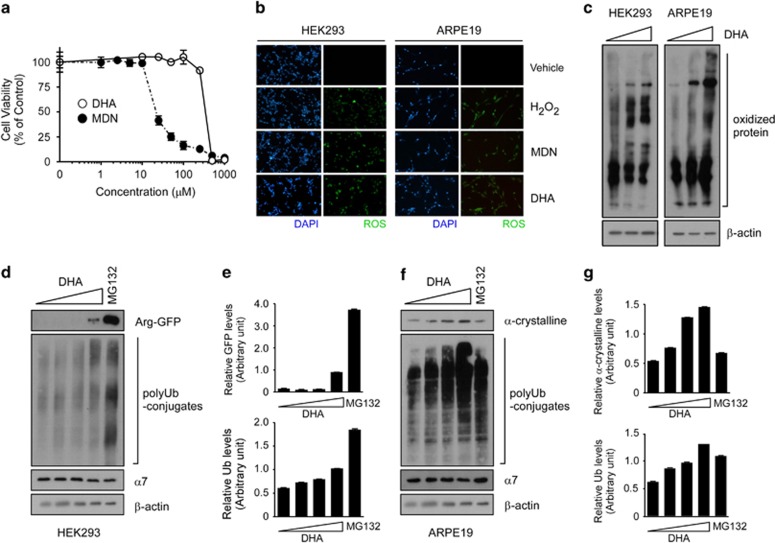Figure 1.
Docosahexaenoic acid (DHA) produces reactive oxygen species (ROS) and perturbs ubiquitin-proteasome system (UPS) flux in cells. (a) The cytotoxicity of ROS inducers such as DHA and menadione on HEK293 cells was measured with MTT assay. Values represent means±s.d. (n=4). (b) Cellular ROS were detected with fluorescence microscopy using CM-H2DCF-DA. HEK293 and ARPE19 cells were treated with DHA (200 μM), H2O2 (200 μM) or menadione (MDN, 10 μM) for 4 h before treatment with 10 μM H2 DCF-DA for 10 min and counterstaining with 4′,6-diamidino-2-phenylindole (DAPI). (c) After HEK293 and ARPE19 cells were incubated with DHA (200 μM) for 4 h, whole-cell extracts (WCEs) were prepared and treated with 2,4-dinitrophenyl hydrazine (DNPH). Immunoblotting analysis was performed with anti-DNP antibody to visualize the total oxidized proteins. β-actin, loading control. (d) HEK293-derived cells stably expressing Arg-GFP were treated with DHA (0, 50, 100 or 250 μM) or MG132 (10 μM) for 4 h. WCEs were analyzed with SDS–PAGE/immunoblotting (IB) using the indicated antibodies. Accumulated polyubiquitin (polyUb) conjugates indicate downregulated ubiquitin–proteasome system (UPS) flux in the cells. (e) Quantification of Arg-GFP or total polyUb conjugate levels in d. (f) As in d, except that α-crystalline was transiently overexpressed in ARPE19 cells. (g) Quantification of α-crystalline or total polyUb conjugate levels in f.

